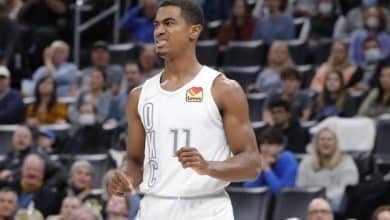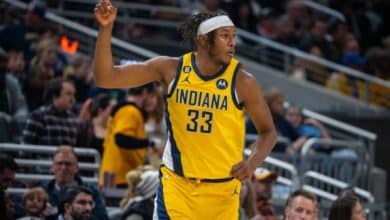
Their names probably mean nothing to you, and yet, Ozzie Silna and Daniel Silna are today at the head of a colossal fortune estimated at 800 million dollars. They owe it only to the NBA, and to what remains to this day the most incredible contract in the history of American sport. To understand the fabulous story of the Silna brothers and the Spirits of St. Louis, let’s first go back nearly 50 years…
The American Basketball Association, the rival league
In the modern history of American sport, that is to say after the end of the Second World War, the supremacy of major leagues such as the NFL (American football) or the MLB (baseball) has never been contested… or almost . The NBA has indeed experienced a fierce rivalry with a breakaway league, the American Basketball Association, or ABA. Born in 1967 as an alternative to the NBA, whose criteria were considered far too strict for the creation of new franchises, the ABA quickly became a model of innovation in many areas: establishment of the three-point line, creation of the Slam Dunk Contest, colorful jerseys, entertainment during time-outs… The ABA also managed to attract some of the best players of the time, such as Julius Erving, Moses Malone, George Gervin and Rick Barry.
However, despite undeniable assets both on the sporting level and the spectacle offered to spectators, the ABA has never really been able to develop and grow because its leaders, unlike those of the NBA, have never had the business knowledge. Despite the level of play offered, the ABA has never been entitled to a television contract worthy of the name. The chaotic management of the league has slowed its growth and harmed its stability, with for example the bankruptcy of two franchises (in Miami and Pittsburgh) in 1972, barely five years after its creation. Gradually, the NBA continued to see its influence grow, leaving only the crumbs to its competitor.
In 1975, the ABA was on the verge of asphyxiation. Three of the league’s ten franchises, the Baltimoles Claws, the San Diego Sails and the Utah Stars, decided to stop the costs and throw in the towel at the end of the regular season following absolutely catastrophic financial results. The seven survivors know it: barring a miracle, the following season will be the “last of the last” for the ABA. The last championship title goes to the New York Nets of Julius Erving, who defeated the Denver Nuggets in the final. But the sporting aspect is already almost anecdotal… In May, the Virginia Squires, the league’s former stronghold, went out of business, unable to pay their players and employees and leaving a hole of more than 75,000 dollars in the ABA fund. The vice has finally tightened on the league, which has no other choice but to start negotiations with its great rival, the NBA.
During the summer of 1975, the Denver Nuggets and the New York Nets had already tried to obtain an exit bond to join the NBA but they were then forced to fulfill their contractual obligations by court order. The death of the ABA will therefore be decided around a round table.
Four elected for six candidates
At the time of the merger, or rather absorption, the NBA already had eighteen franchises. Meeting in congress a few weeks before the end of the ABA, the owners of the NBA franchises decided to incorporate four teams from the ABA, no more, no less. They just had to choose which of the Denver Nuggets, Indiana Pacers, Kentucky Colonels, New York Nets, San Antonio Spurs and Spirits of St Louis. The debates are heated even if a few names quickly emerge as priority targets. The ABA’s top teams across the board, the Nuggets and Nets were unanimous, despite protests from the Knicks over bringing in their neighbors. A financial agreement has been reached in order to obtain the endorsement of the Manhattan-based franchise(1) . The Spurs, very popular throughout Texas, will be the third choice.
For the fourth and final team, consensus was difficult to find. All the signals were green for a successful integration of the Colonels: a solid workforce with a star like Artis Gilmore, a base of loyal and dedicated supporters, and an owner close to his team. Only here, the name of Gilmore posed a problem. Indeed, the Chicago Bulls have vetoed, refusing the arrival of the Colonels in the NBA, in order to be able to hire the six-time All-Star … So remained the Pacers and the Spirits. The NBA had already had experiences in its two cities (Indianapolis in the early 1950s with the Jets and Olympians, and the Hawks in St. Louis from 1955 to 1958), but the Hawks’ stint in Missouri had gone badly. finished and the league did not want to take the risk of setting foot there again, thus leaving the last sesame to the Pacers.
Nets, Nuggets, Pacers, Spurs: these are the four chosen ones. All that remains is to convince the owners of the Colonels and the Spirits to end their franchise in order to be able to close the ABA’s chapter in the great history of basketball forever.
A young NBA executive, David Stern, leads the negotiations
The NBA appoints one of its young leaders to lead negotiations with the last six ABA franchises, a certain David Stern, then thirty-three years old. This beautiful world meets in the small town of Hyannis, on the tip of Cape Cod in Massachusetts, June 17, 1976… The objective is to obtain the agreement of John Y. Brown, the owner of the Kentucky Colonels, and of brothers Ozzie and Daniel Silna, his counterparts of the Spirits of St. Louis.
Convinced that he could one day make a comeback by buying an NBA franchise, Brown quickly agrees with Stern and he decides to cease the activities of his franchise against a check for three million dollars, plus the buyout of his players. . Brown was right. A few months later, he acquired the Buffalo Braves before taking over the management of the Boston Celtics from 1978 to 1979. He then left the world of basketball and became Governor of Kentucky.
If the negotiations were quick and efficient with Brown, they are much less so with the Silna siblings… They have no intention of letting their team down and they want to join the NBA at all costs. While the meeting was supposed to last only a few hours, it will finally continue for three days and three nights, but Stern still manages to snatch an agreement. This stipulates that the Spirits of St. Louis will cease to exist in exchange for a check for $2.2 million, and the payment by each of the four franchises absorbed of one seventh of their income generated by television rights. , or four-sevenths of the amount collected by each NBA franchise, all in perpetuity. It’s those two little words, for life », which make all the genius of the contract.
They don’t know it yet, but the Silna brothers have the contract of the century in their pocket…
At the time, league rights traded for a mere $1.5 million, leaving just about $70,000 per year per team. A misery… But that will quickly change, with the emergence of players such as Magic Johnson and Larry Bird from the end of the 1970s, and a certain Michael Jordan in 1984. Television rights then exploded, climbing year after year so exponential: 20 million in 1985, 275 million in 1990, 400 million in 1995, 840 million in 2000, and today nearly three billion dollars.
This is how the Silna brothers pocketed nearly twenty-five million dollars each season as the owner of a franchise that has not played a single second of basketball for 38 years! Until they accept an offer from the NBA to end the conflict, with a handsome check for $500 million! Ironically, the NBA had tried to renegotiate this cursed contract in 1982, offering the sum of five million to the Silna brothers. The latter had then said that they agreed to break the said contract in exchange for eight million dollars, a requirement refused by the NBA which must be biting its fingers even today.
Finally, in 2014, year of agreement, the Silna brothers had collected no less than 775 million dollars. At the time, if they had wanted to, they could have afforded an NBA franchise since the average value was around $600 million. They are not the only ones to have hit the jackpot since the agreement promised 10% of the income to their lawyer, Donald Schupak, who therefore pocketed around 80 million dollars between 1976 and 2014.
The final agreement that marks the death of the ABA
The rules of the game imposed by David Stern are both strict and restrictive, but such is the price to pay for the four franchises in order to be able to integrate the very profitable NBA:
• Only four ABA franchises will be invited to join the NBA
• The arrival of new franchises will be treated as an expansion, not a merger, meaning they will have to pay a $3.2 million entry fee to play in the NBA.
• The New York Nets will also have to pay the New York Knicks $4.8 million to compensate for the “invasion” of their territory.(1)
• The four ABA franchises will receive no TV rights during their first three seasons in the NBA, and they will have to pay one-seventh of their TV revenues to the owners of the Spirits of St. Louis after 1979, in perpetuity.
• The four ABA franchises will not have voting rights at the annual convention for two years.
• The players of the two franchises left out, the Kentucky Colonels and the Spirits of St. Louis, will have to release their players to the NBA for a “Dispersal Draft” (the opposite of an “Expansion Draft).(2)
• None of the ABA records will be endorsed by the NBA.
Epilogue
It was therefore the Silna brothers who had the last word with this agreement initialed in 2014. If the Spirits of St. Louis only exist on the “Hardwood Classic” jerseys, they still have the craziest contract today. of sports history. They were right in counting on the explosion of television rights, at a time when this medium had not yet fully entered into mores. In 2006, ABA alumni threw a big party to celebrate the thirtieth anniversary of the league’s demise. Ozzie and Daniel Silna were of course there and they offered all the guests a cap with the Spirits logo. As a foot in the NBA, we could read on the back “In Spirit – In Perpetuity”…
_________________________________________________________
(1) In exchange for canceling the $4.8 million payout, the Nets offered to trade superstar Julius Erving to the Knicks, but the Knicks refused. In order to make the payment, Nets executives sold Erving to the Philadelphia 76ers for $3 million. In effect, the Nets traded “Dr. J” for a spot in the NBA.
(2) The Kentucky Colonels received $1.37 million from the sale of their players, including $1.1 million for Artis Gilmore alone, bought by the Chicago Bulls. The Spirits of St. Louis hit $1.45 million, with the sale of Marvin Barnes to the Boston Celtics for $500,000, and Moses Malone and Maurice Lucas to the Portland Trail Blazers for $350,000 and $300,000 respectively.














